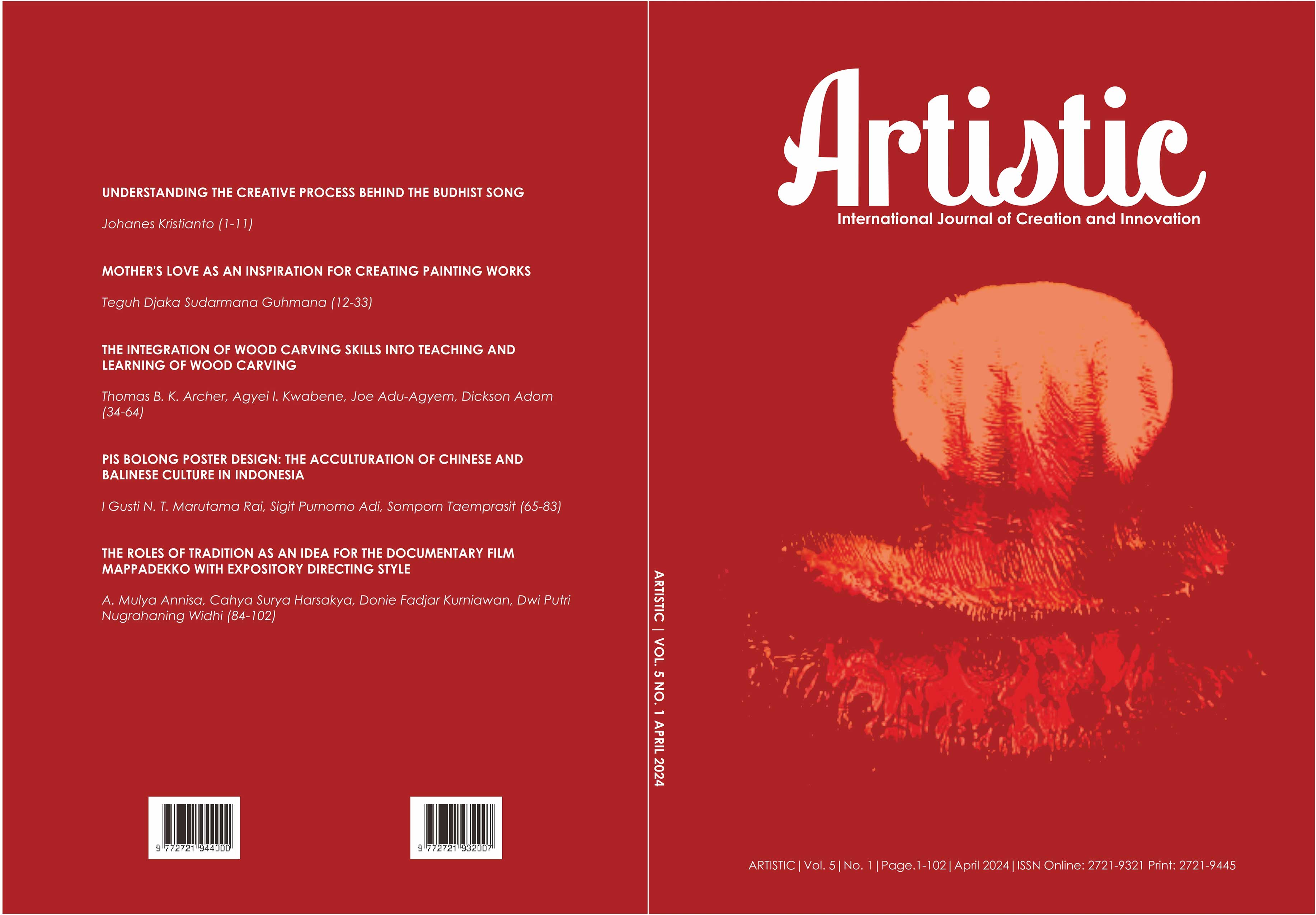MOTHER'S LOVE AS AN INSPIRATION FOR CREATING PAINTING WORKS
DOI:
https://doi.org/10.33153/artistic.v5i1.5905Keywords:
Keywords: love, mother, painting, mixed mediumAbstract
The study of the creation of this work began with an interest in mothers’ love in sincerely nurturing their children and families. Once elaborated, a mother's love is eventually the fruits of the spirit (Galatians 5:22-23). This creation study uses an emic approach to understand the meaning of maternal love as perceived by mothers at the Bhakti Kasih Bunda nursing home in Surakarta. This creation study stage was divided into several steps in creating the work: (1) data collection through field observations, literature studies, and in-depth interviews with mothers at the Bhakti Kasih Bunda nursing home as well as Christian and Confucian religious leaders; (2) data analysis and conclusions as a source of work creation; (3) the process of creating works, which involves stages of experimentation, contemplation, and execution. he result of this creation study was a painting that uses mixed media with collage techniques. The works were divided into four parts based on subject matter, all of which are metaphors for maternal love as the fruit of the spirit. The four parts are the earth and the solar system, humans, animals, and plants.
Downloads
References
Asfryati, A. (2003). Ibu dan Peranannya dalam Kehidupan. Jakarta: EGC.
Barthes, R. (1957). Mythologies.
Berger, A. A. (2005). Tanda-Tanda dalam Kebudayaan Komtemporer: Suatu Pengantar Semiotika. Yogyakarta: Tiara Wacana.
Budiman, K. (2004). Semiotika Visual. Yogyakarta: Buku Baik.
Chatrudi, M. P., & Jalali, M. (2012). Trees: Symbols of Unification, Love, and Peace among Civilizations. Theology Today, 69(1), 73–84. https://doi.org/10.1177/0040573611434584
Conroy, E. (1921). The Symbolism of Colour. London: William Rider & Son, Limited.
Dharsono. (2007). Estetika. Bandung: Rekayasa Sains.
Duncan, C. (1973). Happy Mothers and other New Ideas in French Art. The Art Bulletin, 55(4), 570–583.
Guntur. (2016). Metode Penelitian Artistik. Surakarta: ISI Press.
Hawkins, A. M. (2003). Moving From Whitin: A New Method of Dance Making [Bergerak Menurut Kata Hati : Metoda Baru Dalam Menciptakan Tari]. Jakarta: Masyarakat Seni Pertunjukan Indonesia (MSPI).
Hoed, B. H. (2011). Semiotika dan Dinamika Sosial Budaya. Depok: Komunitas Bambu.
Kartika, D. S. (2004). Seni Rupa Modern. Bandung: Rekayasa Sains.
Kartika, D. S. (2016). Kreasi Artistik: Perjumpaan Tradisi Modern dalam Paradigma Kekaryaan Seni. Karanganyar: Citra Sains LPKBN.
Meir, I., & Cohen, A. (2018). Metaphor in Sign Languages. Sec. Psychology of Language, 9. https://doi.org/https://doi.org/10.3389/fpsyg.2018.01025
Rahyono, F. X. (2011). Kesadaran Pandum dan Laku: Sebuah Solusi Demokratis yang Mengarifkan Karakter Manusia. Konggres Bahasa Jawa V Di Hotel JW Marriot Surabaya.
Razak, R. B. A., & Abdullah, R. bin. (2019). The Emotional Gaze: A Symbol of My Mother’s Deep Reflections in Term of Artwork. Idealogy, 3(4), 85–91.
Sari, L. P. … Kartika, D. S. (2021). Transformation of Tengkuluk Tandukwith Weaving Techniques. ARTISTIC : International Journal of Creation and Innovation, 2(1), 42–51. https://doi.org/10.33153/artistic.v2i1.3925
Suryana, C. (2018). Makna Simbolik dan Wujud Estetik Naga dalam Kebudayaan Jawa pada Sengkalan Dwi Naga Rasa Tunggal dan Dwi Naga Rasa Wani di Keraton Yogyakarta. ARTic, 2, 83–91. https://doi.org/10.34010/artic.2018.2.2526.83-91
Tabrani, P. (2012). Bahasa Rupa. Bandung: Kelir.
Zoest, A. van. (1993). Semiotika: Tentang Tanda, Cara Kerjanya dan Apa Yang Kita Lakukan Dengannya. Jakarta: Yayasan Sumber Agung.
Downloads
Published
How to Cite
Issue
Section
License
Copyright (c) 2024 Teguh Djaka Sudarmana Guhmana

This work is licensed under a Creative Commons Attribution-NonCommercial-ShareAlike 4.0 International License.
Copyright
Authors who publish with Artistic agree to the following terms:
- Authors retain copyright and grant the journal right of first publication with the work simultaneously licensed under a Creative Commons Attribution License (CC BY-SA 4.0) that allows others to share the work with an acknowledgment of the work's authorship and initial publication in this journal.
- Authors are able to enter into separate, additional contractual arrangements for the non-exclusive distribution of the journal's published version of the work (e.g., post it to an institutional repository or publish it in a book), with an acknowledgment of its initial publication in this journal.
This work is licensed under a Creative Commons Attribution-ShareAlike 4.0


